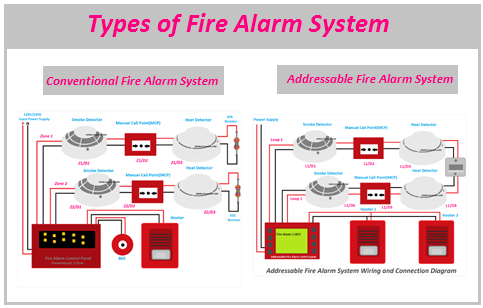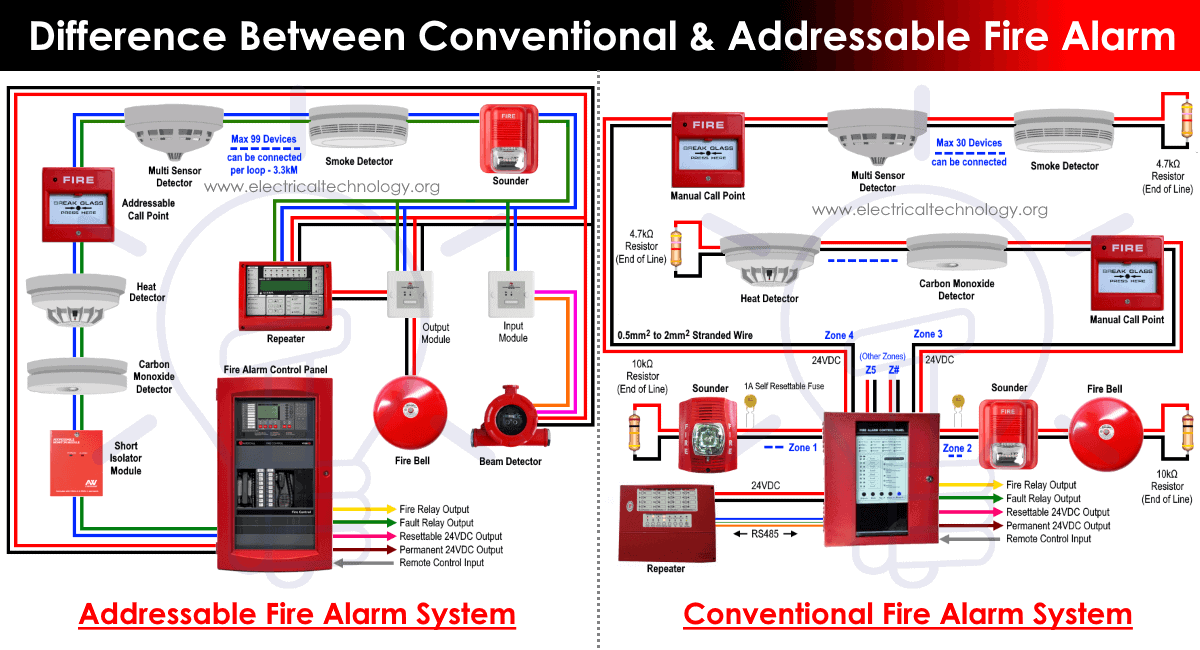Phone:
(701)814-6992
Physical address:
6296 Donnelly Plaza
Ratkeville, Bahamas.

Addressable fire alarm systems pinpoint the exact location of an alarm, while conventional systems indicate a general zone. The former offers greater precision in identifying fire incidents.
Choosing the right fire alarm system is crucial for safety and emergency response efficiency. Addressable systems offer advanced features, such as the ability to identify the precise location of a detector within a building, enhancing the speed and accuracy of emergency services.
Conventional systems, on the other hand, are simpler and cost-effective, but only provide a general indication of the alarm’s location, divided into broader zones. Both systems play a key role in protecting lives and property, but the choice between them depends on the specific needs and complexity of the facility. Safety professionals must consider factors like building size, layout complexity, and budget when selecting an appropriate fire alarm setup.

Credit: www.linkedin.com
The Basics of Fire Alarm Systems play a crucial role in safeguarding lives and property. These systems detect fires early, alert occupants to danger, and can help contain a fire until emergency services arrive. Understanding the different types of systems is key to selecting the right one for your needs.
Addressable fire alarm systems provide specific information about individual alarms. Each detection device has a unique address. This means fast, accurate location of the trigger point. It’s an advanced system, often used in complex buildings.
Conventional fire alarm systems split the covered area into zones. Each zone connects multiple devices. When one device triggers, the entire zone lights up on the control panel. This system works well for smaller, less complex environments.
| Feature | Benefit |
|---|---|
| Simple Configuration | Easy setup and operation. |
| Cost-Effective | Suitable for smaller budgets. |
| Zone-Based Alerts | General area of alert is known. |

Credit: www.electricaltechnology.org
Comparing technologies between addressable and conventional fire alarm systems is critical for understanding their capabilities in fire detection and safety. Let’s explore the nuances of each system, highlighting crucial differences which dictate their deployment and performance in real-world scenarios.
The fundamental aspect that differentiates addressable from conventional fire alarm systems is the wiring layout:
| Conventional System | Addressable System |
|---|---|
| Multiple wires for zones | Single loop for all devices |
| Difficult to pinpoint specific alarms | Precise location identification |
These fire alarm systems also employ different methods for signalling and communication:
Addressable devices send data to the panel, offering superior information management and control. Conventional systems provide limited data, signaling only the activated zone, not the precise device in question.
Installing a fire alarm system is essential for ensuring safety. But choosing between addressable and conventional systems can be tricky. The decision largely depends on the specific needs of the installation scenario. Let’s explore the ideal circumstances for each type of system.
Addressable fire alarm systems shine in complex and large buildings. These systems’ ability to precisely locate alarms makes them perfect for places like:
The structured data these systems provide is invaluable for safety officers managing emergency responses. This detailed alert system allows for swift, guided evacuations and immediate action.
Conventional fire alarm systems are ideal for smaller settings where complexity is not an issue. They are well-suited for:
| Location | Reason |
|---|---|
| Small retail shops | Cost-effective and simple to manage |
| Individual restaurants | Easy to install in a single, compact area |
| Small warehouses | Low maintenance needs for less complex spaces |
Conventional systems are less expensive and easier to install, which makes them a great choice for budget-conscious businesses with a basic layout.
Understanding the differences between addressable and conventional fire alarm systems is key to optimizing operational efficiency and reliability. Addressable systems offer enhanced error detection and simpler maintenance needs, proving to be more reliable and user-friendly in various settings.
Addressable fire alarm systems boast superior operational efficiency through advanced error-detection capabilities. Each device on the network has a unique identifier. This allows pinpointing the exact location and type of issue, be it a smoke detector malfunction or a manual call point activation:
Conventional systems, in comparison, may require more time for issue localization as they indicate only a zone, not a specific device.
From a servicing perspective, addressable systems outshine conventional systems:
| Feature | Addressable System | Conventional System |
|---|---|---|
| Ease of maintenance | Better | Good |
| Downtime | Minimal | More Likely |
| Cost over time | Lower | Higher |
With detailed data available, technicians can address specific components instead of inspecting an entire zone. This streamlines maintenance, minimizes system downtime, and potentially lowers costs over time due to focused and efficient servicing.
Choosing the right fire alarm system affects your pocket. It can save lives and money. Let’s dive into the costs of addressable and conventional fire alarm systems.
The upfront cost is key in decision-making. Addressable systems are more advanced. They have higher initial costs. Yet they offer more features. Conventional systems cost less at first. They are simpler and easier to install.
| System Type | Components Needed | Installation Complexity | Initial Cost |
|---|---|---|---|
| Addressable | Control panel, detectors, modules | High | Higher |
| Conventional | Control panel, detectors | Low | Lower |
Think about your building’s needs. Size and complexity matter. This will guide your initial investment decision.
Look beyond initial costs. Consider long-term expenses too. Addressable systems can mean lower life cycle costs. They have smarter maintenance and less false alarms.
A detailed analysis will show which system saves money in the long run. Smart choices now can lead to fewer costs later.
Fire alarm systems have come a long way. New technologies make buildings safer. They are smarter and connect better. We see two main types: Addressable and Conventional. Let’s explore how they fit into today’s smart buildings.
Smart buildings use technology to save energy and improve safety. Addressable fire alarm systems fit right into this. They talk to other systems in a building. This helps with quick responses to emergencies. Alarms can now:
Changing from conventional to addressable offers clear benefits. Let’s compare them:
| Feature | Conventional System | Addressable System |
|---|---|---|
| Location Detection | General area | Exact device |
| Maintenance Alerts | No | Yes, with details |
| Integration | Limited | Extensive |
Upgrades include better safety and control. Addressable systems make finding fire sources easier. They also self-check and report problems. This means maintenance is proactive. Buildings become safer and smarter.

Credit: firesystems.net
Addressable fire alarm systems tend to be more expensive than conventional ones. They can be complex to install and maintain, which might incur higher upfront and ongoing costs. Additionally, they might generate false alarms if not properly configured or maintained.
An addressable fire alarm system precisely locates fire sources, enhancing emergency response. It improves safety through individual device monitoring and simplifies maintenance with clear error identification.
Conventional fire alarm systems offer cost-effectiveness and simplicity, making them ideal for small structures. They are easy to install and maintain, ensuring reliable fire detection.
There are two main types of fire alarm systems: conventional and addressable. Conventional systems divide the building into zones, while addressable systems pinpoint the exact location of the alarm.
Deciding between addressable and conventional fire alarm systems is pivotal for safety. Addressable systems offer location-specific alerts, suitable for complex structures. Conventional units are cost-efficient for smaller spaces. Remember, the right choice hinges on your facility’s size and layout, ensuring prompt, reliable fire detection and response.
Choose with foresight; safety depends on it.